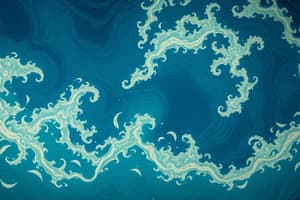Podcast
Questions and Answers
What is the effect of Ekman transport in the Northern Hemisphere?
What is the effect of Ekman transport in the Northern Hemisphere?
- It moves water to the left
- It deflects water to the right (correct)
- It causes water to pile up at the edges
- It creates a counterclockwise motion
What forms at the center of a subtropical gyre due to water piling up?
What forms at the center of a subtropical gyre due to water piling up?
- Water bowl
- Water hill (correct)
- Water dome
- Water mound
How does the Coriolis effect influence geostrophic currents?
How does the Coriolis effect influence geostrophic currents?
- It causes them to flow downhill
- It has no effect on the currents
- It creates vertical movement in the water
- It opposes gravity and curves the flow rightward (correct)
Which current is significantly faster than the California current?
Which current is significantly faster than the California current?
What is western intensification?
What is western intensification?
What effect does the Coriolis effect have on water flowing towards the equator?
What effect does the Coriolis effect have on water flowing towards the equator?
What happens to the velocity of water around the apex of the hill in a gyre?
What happens to the velocity of water around the apex of the hill in a gyre?
What is the term used to describe the slower flow of water across the subtropical gyre?
What is the term used to describe the slower flow of water across the subtropical gyre?
What causes equatorial upwelling?
What causes equatorial upwelling?
What effect does downwelling have on deep sea conditions?
What effect does downwelling have on deep sea conditions?
Why is the equator considered a prolific fishing ground?
Why is the equator considered a prolific fishing ground?
Which of the following describes the path of water during downwelling?
Which of the following describes the path of water during downwelling?
What role do coastal winds play in upwelling and downwelling?
What role do coastal winds play in upwelling and downwelling?
What occurs when surface waters converge?
What occurs when surface waters converge?
What is a characteristic of downwelling regions?
What is a characteristic of downwelling regions?
How does Ekman transport influence surface water movement in the Northern Hemisphere?
How does Ekman transport influence surface water movement in the Northern Hemisphere?
What is the effect of Ekman transport when it brings water away from the shoreline?
What is the effect of Ekman transport when it brings water away from the shoreline?
Which of the following factors can cause other water pathways besides Ekman transport?
Which of the following factors can cause other water pathways besides Ekman transport?
What occurs during the warm phase of the El Nino Southern Oscillation (ENSO)?
What occurs during the warm phase of the El Nino Southern Oscillation (ENSO)?
What happens to water levels in the western Pacific during the ENSO warm phase?
What happens to water levels in the western Pacific during the ENSO warm phase?
What is the main cause of extreme weather conditions during ENSO events?
What is the main cause of extreme weather conditions during ENSO events?
During the cool phase of ENSO, what is true about the air pressure in the western Pacific?
During the cool phase of ENSO, what is true about the air pressure in the western Pacific?
What is a characteristic effect of the ENSO cool phase on trade winds?
What is a characteristic effect of the ENSO cool phase on trade winds?
How frequently do El Nino and La Nina events occur?
How frequently do El Nino and La Nina events occur?
What effect does upwelling have on water sources according to the provided information?
What effect does upwelling have on water sources according to the provided information?
What happens in terms of water dynamics when coastal winds blow offshore?
What happens in terms of water dynamics when coastal winds blow offshore?
Flashcards
Water Hills
Water Hills
A mound of water formed in the center of a subtropical gyre due to the convergence of water caused by Ekman transport.
Geostrophic Current
Geostrophic Current
A current that flows parallel to the contours of a water hill, resulting from a balance between gravity pulling the water downhill and the Coriolis effect deflecting it rightward.
Western Intensification
Western Intensification
A phenomenon where western boundary currents in subtropical gyres are faster, narrower, and deeper compared to their eastern counterparts.
Why are Western Boundary Currents Faster?
Why are Western Boundary Currents Faster?
Signup and view all the flashcards
What drives Western Intensification (1)?
What drives Western Intensification (1)?
Signup and view all the flashcards
What drives Western Intensification (2)?
What drives Western Intensification (2)?
Signup and view all the flashcards
Bottleneck Effect
Bottleneck Effect
Signup and view all the flashcards
Kuroshio vs. California Current
Kuroshio vs. California Current
Signup and view all the flashcards
Upwelling and Downwelling
Upwelling and Downwelling
Signup and view all the flashcards
Divergence in Upwelling
Divergence in Upwelling
Signup and view all the flashcards
Equatorial Upwelling
Equatorial Upwelling
Signup and view all the flashcards
Ekman Transport
Ekman Transport
Signup and view all the flashcards
Convergence in Downwelling
Convergence in Downwelling
Signup and view all the flashcards
Coastal Wind Upwelling/Downwelling
Coastal Wind Upwelling/Downwelling
Signup and view all the flashcards
Downwelling's Impact on Productivity
Downwelling's Impact on Productivity
Signup and view all the flashcards
Gulf Stream and Labrador Current Convergence
Gulf Stream and Labrador Current Convergence
Signup and view all the flashcards
Upwelling
Upwelling
Signup and view all the flashcards
Downwelling
Downwelling
Signup and view all the flashcards
El Niño Southern Oscillation (ENSO)
El Niño Southern Oscillation (ENSO)
Signup and view all the flashcards
ENSO Warm Phase (El Niño)
ENSO Warm Phase (El Niño)
Signup and view all the flashcards
ENSO Cool Phase (La Niña)
ENSO Cool Phase (La Niña)
Signup and view all the flashcards
Trade Winds
Trade Winds
Signup and view all the flashcards
Thermocline
Thermocline
Signup and view all the flashcards
Equatorial Countercurrent
Equatorial Countercurrent
Signup and view all the flashcards
Pacific Warm Pool
Pacific Warm Pool
Signup and view all the flashcards
Study Notes
Ocean Circulation
- Ekman transport moves water to the right in the Northern Hemisphere and to the left in the Southern Hemisphere. This is due to the Coriolis effect.
- Ekman transport contributes to the clockwise rotation of northern subtropical gyres.
- Subtropical convergence creates water hills in the center of gyres. These "water hills" can be up to 2 meters higher than the surrounding water.
- Geostrophic currents are a result of the balance between gravity and the Coriolis effect. Gravity pulls water downhill, while the Coriolis effect curves the flow.
- The net effect of these forces results in a circular current around the water hill.
- Geostrophic currents move in a circular path around the water hill.
- The apex of the water hill is closest to the western boundary current.
- Western boundary currents are faster, narrower, and deeper than eastern boundary currents. An example is the Kuroshio current.
- Western intensification is the phenomenon where currents near the western edges of ocean basins are stronger than those near the eastern edges. This is due to the Coriolis effect in combination with the shape of the water hills.
- Western intensification impacts the flow of water toward the equator.
- Upwelling occurs due to the divergence of surface waters or from coastal winds.
- Downwelling occurs due to the convergence of surface waters.
- Upwelling and downwelling are driven by the need to fill gaps in volume. Water lost equals upwelling, water gained equals downwelling.
- Coastal winds can cause upwelling/downwelling due to Ekman transport. This depends on whether winds are blowing parallel to the coast in a way that pushes water away from the coast.
- Other factors that may cause upwelling (or downwelling) include offshore winds, seafloor obstructions, coastal geometry bends
El Niño Southern Oscillation (ENSO)
- ENSO leads to extreme conditions like droughts and extreme rainfall.
- ENSO is caused by the weakening of Pacific winds and belts. This weakens the trade winds and results in the changing pressure between the west and east of the Pacific.
- During an El Niño event, pressure decreases in the east and central Pacific, and it increases in the west. The opposite is true for La Niña.
- ENSO events are caused by changes in winds and pressure patterns.
- El Niño and La Niña occur every 2 to 10 years.
- El Niño events are characterized by warming of waters in the equatorial Pacific and weakening trade winds.
- During El Niño, the Pacific Warm Pool can flow back eastward, enhancing upwelling and mixing reducing the thermocline.
- La Niña is an event opposite from El Niño.
- In La Niña, air pressure is higher than normal in the west.
Studying That Suits You
Use AI to generate personalized quizzes and flashcards to suit your learning preferences.




